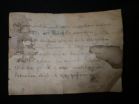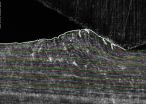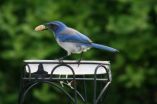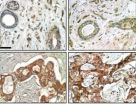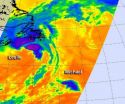(Press-News.org) In the late 1800s, a flurry of fossil speculation across the American West escalated into a high-profile national feud called the Bone Wars.
Drawn into the spectacle were two scientists from the Lone Star State: geologist Robert T. Hill, now acclaimed as the Father of Texas Geology, and naturalist Jacob Boll, who made many of the state's earliest fossil discoveries.
Hill and Boll had supporting roles in the Bone Wars through their work for one of the feud's antagonists, Edward Drinker Cope. A new study by vertebrate paleontologist Louis L. Jacobs at Southern Methodist University, Dallas, unveils new details about their roles and the Bone Wars in Texas.
Jacobs discovered 13 historic letters written by Cope to Hill. Jacobs found the letters in an archive of Hill's papers at SMU's DeGolyer Library. The letters span seven years, from 1887 to 1894.
Hill, who worked for the U.S. Geological Survey, not only provided Cope with fossils of interest but also shared geological information about fossil locales.
As for Boll, he wrote an ode in his native German to an important fossil he supplied to Cope. Jacobs came across the poem in the American Museum of Natural History. He and his co-authors on the study present an English translation of the poem.
Boll, who was a paid collector for Cope — as was the practice at the time — supplied the well-known paleontologist with many fossils from Texas. More than 30 of the taxa ultimately named by Cope were fossils collected by Boll.
"Fossils collected by Boll and studied by Cope have become some of the most significant icons in paleontology," said Jacobs, an SMU professor of earth sciences.
Jacobs' study, "Jacob Boll, Robert T. Hill, and the Early History of Vertebrate Paleontology in Texas," is published in the journal Historical Biology: An International Journal of Paleobiology as part of the conference volume of the 12th International Symposium on Early Vertebrates/Lower Vertebrates. Images of the Cope letters, along with Cope's signature, are at http://bit.ly/Sky2Op, as well as an image of the slip of paper with Boll's original German poem.
Rush to find fossils explodes during opening of the American West
Jacobs describes the late 1800s as a period of intense fossil collecting. The Bone Wars were financed and driven by Cope and his archenemy, Othniel Charles Marsh. The two were giants of paleontology whose public feud brought the discovery of dinosaur fossils to the forefront of the American psyche.
Cope, from Philadelphia, and Marsh, from Yale University, began their scientific quests as a friendly endeavor to discover fossils. They each prospected the American frontier and also hired collectors to supply them with specimens. Cope and Marsh identified and named hundreds of discoveries, publishing their results in scientific journals.
Over the course of nearly three decades, however, their competition evolved into a costly, self-destructive, vicious all-out war to see who could outdo the other. Despite their aggressive and sometimes unethical tactics to outwit one another and steal each other's hired collectors, Cope and Marsh made major contributions to the field of paleontology, Jacobs said.
Hill first to identify and map the Cretaceous geology in North Texas
Born in 1858, Hill was a teenager when he left Tennessee as an orphan and arrived on the Texas frontier in 1874, says Jacobs' study. Hill settled in Comanche, southwest of Fort Worth, where he went to work for his brother's newspaper, the Chief. After earning a Bachelor of Science in geology from Cornell, Hill was hired as a field geologist for the USGS.
Hill is noted for being the first to identify and map the distinct rock formations in North Texas that correspond to the Earth's Cretaceous geologic period from 146 million years ago to 65 million years ago, Jacobs said. For much of the Cretaceous, a shallow sea cut North America in half from the Arctic to the Gulf of Mexico. Dinosaurs roamed the coastal shoreline and huge reptiles swam the waters, an environment that preserved plants and animals as fossils for posterity millions of years later.
Through his reading of the letters, Jacobs found that Cope disagreed with the way Hill named the Cretaceous rock units, and told him so. Cope counseled Hill: "You mustn't mind criticism. We all get it and get used to it; but it isn't comfortable at first."
In subsequent letters, said Jacobs, it's apparent Hill had changed his approach, for which Cope offered him high praise: "I wish to say definitely that your discovery of the lower Cretaceous series in this country is the most important addition to our geology that has been heard for a long time."
Jacobs' research found that numerous letters reveal that Cope was persistent in trying to buy a Cretaceous fish fossil that Hill had collected. In various letters, Cope expresses a desire to view the fossil, each time stating his request in a different way. Hill ultimately sold Cope the fossil for $15. Cope named the specimen Macrepistius arenatus. It is housed at the American Museum of Natural History in New York City.
Hill's fish specimen was one of 1,000 species of backboned animals, from fish to dinosaurs, that Cope described and named in his lifetime.
Also evident in the correspondence is a glimpse into the battle intrigue between Cope and Marsh, Jacobs said. In one letter, Cope angles to learn from Hill details about a new director of the USGS, to judge whether "our ? friend O.C.M." would have an advantage.
Cope wrote to Hill, "Possibly you can find out how the land lies?"
Cope's other Texas connection was through Jacob Boll
Boll was a much larger supplier to Cope and ultimately made significant contributions to the field of paleontology. Boll "is mentioned, usually in passing, in virtually every history of the subject," according to Jacobs.
VIDEO:
In the late 1800s, furious fossil speculation across the American West escalated into a high-profile national feud called the Bone Wars. Vertebrate paleontologist Louis L. Jacobs unveils how the Bone...
Click here for more information.
Born in 1828 in Switzerland, Boll was the first to discover vertebrate fossils in the Permian red beds along the drainages of the Wichita and Red rivers and their tributaries.
"The discoveries opened up an entirely new chapter in vertebrate evolution some 280 million years old," Jacobs said. "Boll's finds include some of the oldest close relatives of mammals whose evolution eventually led to humans."
Boll belonged to one of the Swiss families that founded the mid-19th century utopian society La Reunion in Dallas, Jacobs said. Boll made Dallas his home sometime after 1874. He died in the field in the Permian red beds in 1880 from a snake bite.
At least one scholar has asserted that Cope — to keep the identity of his collectors secret from Marsh — never credited Boll for the Texan's many fossil discoveries. Jacobs, however, found evidence that in 1878 Cope, in fact, did acknowledge Boll's contribution, at least for the big-headed, semi-acquatic amphibian Eryops. Cope wrote that the fossil was "found … by my friend Jacob Boll."
Boll's fossil fascination erupted into a poem for Eryops
During a break in his field labors, Boll's fascination with ancient bones prompted him to write in his native German an ode to fossils. Jacobs came across the poem in the American Museum of Natural History on a label on the back of Eryops specimen No. AMNH 4183.
SMU biology professor Pia Vogel translated the poem. Vogel and Jacobs worked with SMU English professor John M. Lewis to capture in English the ode's original poetry.
"Now you will with some few others
Trek to the professor's seat.
Awakened through his careful thought,
Be reassembled from your fragments,
To tell to others yet to come
From the sculpting of your teeth
How you lived and disappeared,
Name you he will, and what he found."
While Hill and Boll were linked by their relationship to Cope, it isn't known whether the two of them ever met, according to Jacobs.
"Hill and Boll both made major contributions to frontier science at an important time in American history," Jacobs said. "They may have been nearly forgotten, but their lives have influenced much that came later."
INFORMATION:
Follow SMU Research on twitter at http://twitter.com/smuresearch.
SMU is a nationally ranked private university in Dallas founded 100 years ago. Today, SMU enrolls nearly 11,000 students who benefit from the academic opportunities and international reach of seven degree-granting schools. For more information see www.smuresearch.com.
SMU has an uplink facility located on campus for live TV, radio, or online interviews. To speak with an SMU expert or book an SMU guest in the studio, call SMU News & Communications at 214-768-7650.
Newly discovered letters and translated German ode expand Texas link to infamous Bone Wars
Treasure trove of archived letters to frontier scientist discovered at SMU; Permian hunter’s German ode to a fossil is translated into English
2012-09-12
ELSE PRESS RELEASES FROM THIS DATE:
Scripps Research scientists devise powerful new method for finding therapeutic antibodies
2012-09-12
LA JOLLA, CA, September 11, 2012 – Scientists at The Scripps Research Institute have found a new technique that should greatly speed the discovery of medically and scientifically useful antibodies, immune system proteins that detect and destroy invaders such as bacteria and viruses. New methods to discover antibodies are important because antibodies make up the fastest growing sector of human therapeutics; it is estimated that by 2014 the top-three selling drugs worldwide will be antibodies.
The new technique, described in an article this week published online ahead of ...
Ageism presents dilemmas for policymakers worldwide
2012-09-12
The negative consequences of age discrimination in many countries are more widespread than discrimination due to race or gender, yet differential treatment based on a person's age is often seen as more acceptable and even desirable, according to the newest edition of the Public Policy & Aging Report (PP&AR). This publication, which features cross-national perspectives, was jointly produced by The Gerontological Society of America (GSA) and AGE UK.
The PP&AR explores how discriminatory behaviors manifest themselves, steps that are being taken to address those behaviors, ...
Sliding metals show fluidlike behavior, new clues to wear
2012-09-12
"We see phenomena normally associated with fluids, not solids," said Srinivasan Chandrasekar, a professor of industrial engineering at Purdue University, working with postdoctoral research associates Narayan Sundaram and Yang Guo.
Numerous mechanical parts, from bearings to engine pistons, undergo such sliding.
"It has been known that little pieces of metal peel off from sliding surfaces," Chandrasekar said. "The conventional view is that this requires many cycles of rubbing, but what we are saying is that when you have surface folding you don't need too many cycles for ...
NASA's Global Hawk investigating Atlantic Tropical Depression 14
2012-09-12
NASA's Hurricane and Severe Storm Sentinel (HS3) airborne mission sent an unmanned Global Hawk aircraft this morning to study newborn Tropical Depression 14 in the central Atlantic Ocean that seems primed for further development. The Global Hawk left NASA's Wallops Flight Facility on Wallops Island, Va., this morning for a planned 26-hour flight to investigate the depression.
NASA's latest hurricane science field campaign began on Sept. 7 when the Global Hawk flew over Hurricane Leslie in the Atlantic Ocean. HS3 marks the first time NASA is flying Global Hawks from the ...
Scrub jays react to their dead
2012-09-12
Western scrub jays summon others to screech over the body of a dead jay, according to new research from the University of California, Davis. The birds' cacophonous "funerals" can last for up to half an hour.
Anecdotal reports have suggested that other animals, including elephants, chimpanzees and birds in the crow family, react to dead of their species, said Teresa Iglesias, the UC Davis graduate student who carried out the work. But few experimental studies have explored this behavior.
The new research by Iglesias and her colleagues appears in the Aug. 27 issue of ...
Protein linked to therapy resistance in breast cancer
2012-09-12
A gene that may possibly belong to an entire new family of oncogenes has been linked by researchers with the U.S. Department of Energy (DOE)'s Lawrence Berkeley National Laboratory (Berkeley Lab) to the resistance of breast cancer to a well-regarded and widely used cancer therapy.
One of the world's leading breast cancer researchers, Mina Bissell, Distinguished Scientist with Berkeley Lab's Life Sciences Division, led a study in which a protein known as FAM83A was linked to resistance to the cancer drugs known as EGFR-TKIs (Epidermal Growth Factor Receptor-Tyrosine Kinase ...
What are the effects of the Great Recession on local governments?
2012-09-12
Freezing positions and cutting workforces
Trimming pension and health care costs and passing them to employees
Lowering service delivery levels, but not imposing many new fees
Using technology to reduce costs where possible
Receiving added pressure but little help from States and the Federal Government
This important new research sheds light on the challenges faced by city and county governments that must provide most basic services. Unlike federal or state governments, these local governments have limited ability to generate revenue and are often mandated to pay for ...
NASA infrared data reveals fading Tropical Storm Leslie and peanut-shaped Michael
2012-09-12
When NASA's Aqua satellite passed over the Atlantic on Sept. 11 it caught Tropical Storm Leslie's clouds over Newfoundland and peanut-shaped Tropical Storm Michael to its southwest. The Atmospheric Infrared Sounder (AIRS) instrument captured infrared data on Tropical Storms Leslie and Michael when it passed overhead on Sept. 11.
Michael Appears Peanut-Shaped on Satellite Imagery
Tropical Storm Michael forecast to become a remnant low later today, Sept. 11, but as of 11 a.m. EDT Michael still had maximum sustained winds near 45 mph (75 kmh). It was located about 1,090 ...
Yellow lights mean drivers have to make right choice -- if they have time
2012-09-12
A couple of years ago, Hesham Rakha misjudged a yellow traffic light and entered an intersection just as the light turned red. A police officer handed him a ticket.
"There are circumstances, as you approach a yellow light, where the decision is easy. If you are close to the intersection, you keep going. If you are far away, you stop. If you are almost at the intersection, you have to keep going because if you try to stop, you could cause a rear-end crash with the vehicle behind you and would be in the middle of the intersection anyway," said Rakha, professor of civil ...
Genetic make-up of children explains how they fight malaria infection
2012-09-12
Researchers from Sainte-Justine University Hospital Center and University of Montreal have identified several novel genes that make some children more efficient than others in the way their immune system responds to malaria infection. This world-first in integrative efforts to track down genes predisposing to specific immune responses to malaria and ultimately to identify the most suitable targets for vaccines or treatments was published in the Proceedings of the National Academy of Sciences by lead author Dr. Youssef Idaghdour and senior author Pr. Philip Awadalla, whose ...
LAST 30 PRESS RELEASES:
University of Oklahoma researcher awarded funding to pursue AI-powered material design
Exploring how the visual system recovers following injury
Support for parents with infants at pediatric check-ups leads to better reading and math skills in elementary school
Kids’ behavioral health is a growing share of family health costs
Day & night: Cancer disrupts the brain’s natural rhythm
COVID-19 vaccination significantly reduces risk to pregnant women and baby
The role of vaccination in maternal and perinatal outcomes associated with COVID-19 in pregnancy
Mayo Clinic smartwatch system helps parents shorten and defuse children's severe tantrums early
Behavioral health spending spikes to 40% of all children’s health expenditures, nearly doubling in a decade
Digital cognitive behavioral treatment for generalized anxiety disorder
Expenditures for pediatric behavioral health care over time and estimated family financial burden
Air conditioning in nursing homes and mortality during extreme heat
The Alps to lose a record number of glaciers in the next decade
What makes a good proton conductor?
New science reporting guide published for journalists in Bulgaria
New international study reveals major survival gaps among children with cancer
New science reporting guide published for journalists in Turkey
Scientists develop a smarter mRNA therapy that knows which cells to target
Neuroanatomy-informed brain–machine hybrid intelligence for robust acoustic target detection
Eight SwRI hydrogen projects funded by ENERGYWERX
The Lundquist Institute and its start-up company Vitalex Biosciences Announces Strategic Advancement of Second-Generation fungal Vaccine VXV-01 through Phase 1 Trials under $40 Million Competitive Con
Fine particles in pollution are associated with early signs of autoimmune disease
Review article | Towards a Global Ground-Based Earth Observatory (GGBEO): Leveraging existing systems and networks
Penn and UMich create world’s smallest programmable, autonomous robots
Cleveland researchers launch first major study to address ‘hidden performance killer’ in athletes
To connect across politics, try saying what you oppose
Modulating key interaction prevents virus from entering cells
Project explores barriers to NHS career progression facing international medical graduates
Jeonbuk National University researchers explore the impact of different seasonings on the flavor perception of Doenjang soup
Two Keck Medicine of USC Hospitals named Leapfrog Top Teaching Hospitals
[Press-News.org] Newly discovered letters and translated German ode expand Texas link to infamous Bone WarsTreasure trove of archived letters to frontier scientist discovered at SMU; Permian hunter’s German ode to a fossil is translated into English
